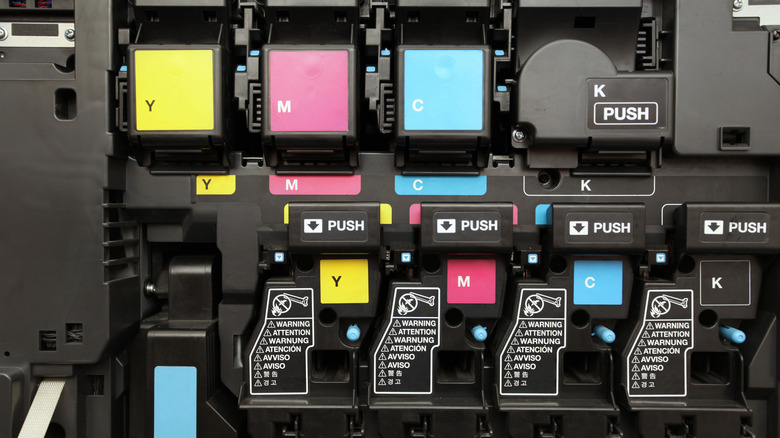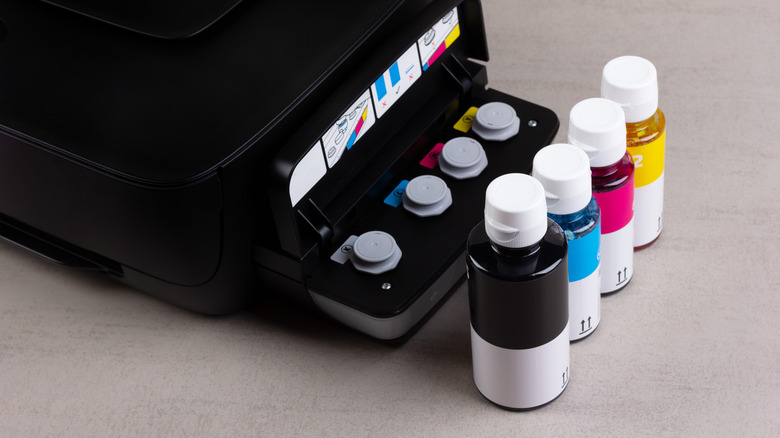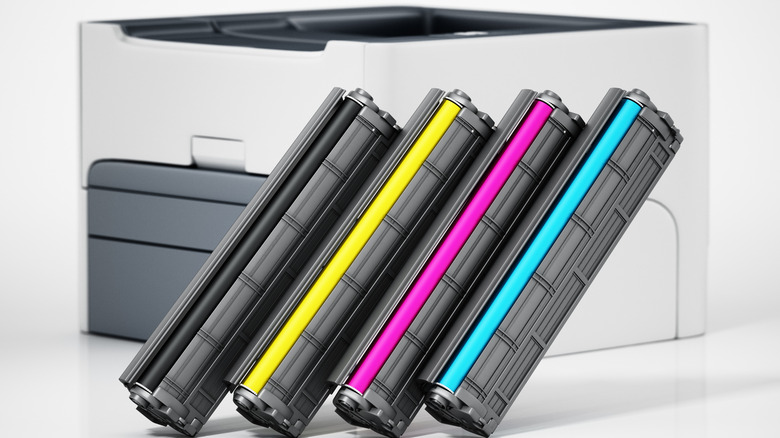Ink Vs. Toner: What's The Difference & Which Is Best For Your Printing Needs
It's a problem not uncommon for many new printer owners — their printer needs a cartridge refill, and now they're at the store, unsure of whether to buy ink or toner or if there's even a difference between the two. Indeed, the vast majority of products from major printer brands rely on either ink or toner to operate properly, but that's not to say that these two components are necessarily interchangeable with one another.
Despite what some may expect, ink and toner are actually far from the same thing and most printer models solely rely on one or the other to print. What's more, there are unique pros and cons to using ink compared to using toner, and vice-versa. With that in mind, here's an overview of what exactly ink and toner are, what the biggest differences are between the two, and which is the better option based on an individual's general printing needs.
What is printer ink?
Printer ink is the component that inkjet printers use to function — and it's pretty similar to most other sorts of ink. Just as with the ink of a pen, printer ink takes the form of a liquid. It is made up of a number of varnishes, resins, pigments, and other additives to optimize its use with a printing machine. Inkjet printers carry out their main function by taking inserted ink cartridges and spraying extremely small drops of their ink onto a piece of paper, allowing for the formation of printed text and images.
Some of the best printers on the market are ink-based, and many of those who own a personal printer typically opt for the inkjet variation. There are a number of benefits to using ink for printing, such as ink cartridges being less expensive to replace than other printing components like toner. Printer ink is also generally considered the superior method for printing complex images, such as photographs, due to its decent flexibility in color output.
Of course, ink isn't a perfect solution for printing, and opting for an inkjet printer potentially comes with several downsides. Like any other form of ink, printer ink is prone to smudging before it dries. Additionally, while ink cartridges typically come at a lower price point than other printer fillers, they are usually quite small and run out fairly quickly if the printer is being used regularly or is undertaking multiple intensive jobs. On the other hand, if an inkjet printer's supply of ink cartridges isn't used regularly, the cartridges have the potential to dry out and become unusable anyway. Either way, users should expect to make fairly frequent return trips to the store for new ink cartridges.
What is printer toner?
Printer toner is the component that is primarily used by laser printers. Unlike printer ink, it is actually a dry, powdery substance that is mostly composed of a granulated plastic polymer and several other compounds. To print using toner, laser printers undergo a complicated process involving static electricity and magnets. Essentially, the printer's internals collect the necessary pigmented toner particles for use in a print job, which are then placed on a metallic drum that subsequently applies them in the proper order to the paper. The paper is then heated enough for the plastic in the toner to melt and bind to the page.
The unique functionality of laser printers that use toner comes with several advantages. By some metrics, the prints from laser printers are more precisely detailed than their ink alternatives and are substantially less prone to smudging. What's more, toner cartridges last far longer than ink cartridges and are capable of outputting a higher volume of prints at a quicker speed. All of these elements are key reasons why laser printers are often found in locations like offices and schools, in which they are used on a near-constant basis by multiple people.
Just as with ink, toner also has its share of disadvantages. The financial barrier to entry to this ecosystem is on the higher end. Laser printers typically cost quite a bit more than inkjet printers, and the general laser printer market is more focused on offering larger, industrial-scale units than affordable ones for personal or recreational use. Additionally, toner cartridges themselves are usually more expensive than ink cartridges, even if they don't have to be replaced quite as often. It's also worth noting that toner is generally less well-equipped to handle very complex printing jobs like photographs.
Which should you buy?
While ink and toner-based printers each have their own set of pros and cons, both are ultimately solid options for getting most printing jobs done. As such, those in the market for a new printer should ultimately base their decision on a few key factors, such as their budget, their typical level of printer usage, and what sort of jobs they're planning to use the machine for.
For those who only need to print something every once in a while or those who simply want a printer for recreational use as a household item, a printer that uses ink is probably the best option. Both inkjet printers and ink cartridges are usually cheaper, and a casual amount of printer use mitigates the problem of having to buy more ink sooner than having to buy more toner. Inkjet printers are also somewhat more versatile and can handle pretty much anything from a basic black-and-white text document to a finely detailed color photograph.
For those who need to print basic documents very frequently or on a mass scale as part of their occupation, a laser printer that uses toner is the way to go. While the cost of buying a laser printer and toner cartridges may be decently higher than the ink-based alternatives, this setup is incredibly capable once it's in the user's hands. Laser printers are particularly ideal for heavy-duty print jobs. For instance, they can produce hundreds of copies of a text-based document with relative speed and ease — perfect for a setting where multiple people need to make large print jobs at a moment's notice.



